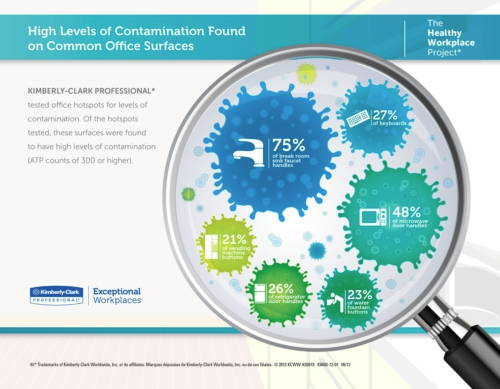 Cleanzine: your weekly cleaning and hygiene industry newsletter 25th April 2024 Issue no. 1111
Cleanzine: your weekly cleaning and hygiene industry newsletter 25th April 2024 Issue no. 1111
Your industry news - first
The original and best - for over 20 years!
We strongly recommend viewing Cleanzine full size in your web browser. Click our masthead above to visit our website version.
New study finds office kitchens and break rooms are 'crawling with bacteria'
 If you thought the restroom was the epicentre of workplace germs you don't want to know about office break rooms and kitchens.
If you thought the restroom was the epicentre of workplace germs you don't want to know about office break rooms and kitchens.
The place where US workers eat and prepare their lunch topped the list of office germ 'hot-spots' with sink and microwave door handles found to be the dirtiest surfaces touched by office workers on a daily basis. (Ed: this is probably reflected in workplaces throughout the world, so be aware of the hazards!)
The findings are from a study carried out by Kimberly-Clark Professional and is believed to be one of the most detailed and comprehensive studies ever conducted on identifying workplace hotspots where germs can lurk.
Hygienists from the company's Healthy Workplace Project collected nearly 5,000 individual swabs from office buildings housing more than 3,000 employees. The participating office buildings represented a broad cross-section of office 'types', including manufacturing facilities, law firms, insurance companies, healthcare companies and call centres.
According to the study, which was carried out in consultation with Dr. Charles Gerba, Professor of Microbiology at the University of Arizona, the percentage of the office surfaces tested and found to have high levels of contamination (an ATP count of 300 or higher), includes:
- 75% of break room sink faucet handles
- 48% of microwave door handles
- 27% of keyboards
- 26% of refrigerator door handles
- 23% of water fountain buttons
- 21% of vending machine buttons
In addition, half of all computer mice and desk phones were found to have ATP levels above 100, suggesting that while people appear to be taking more responsibility for the cleanliness of their personal spaces, there is still a need for increased awareness of the importance of hand and surface hygiene in the office.
The bottom line? Office workers are potentially being exposed to illness-causing bacteria right in their own lunchrooms, as well as elsewhere around the office.
"People are aware of the risk of germs in the restroom, but areas like break rooms have not received the same degree of attention," warnsDr. Gerba. "This study demonstrates that contamination can be spread throughout the workplace when office workers heat up lunch, make coffee or simply type on their keyboards."
The results reinforce the crucial role of contract cleaners, whose services go a long way in successfully disinfecting office common areas at the end of every day. However, because kitchens and personal work spaces can become instantly re-contaminated, employers need to arm their employees with the knowledge and tools necessary to reduce the spread of germs. Simple solutions, like placing sanitising wipes in kitchens and providing employees with easy access to hand sanitisers, underscored by education in hand and surface hygiene, can serve as the impetus to engage employees in maintaining a healthy office environment.
"This study demonstrates that contamination is all over the workplace and has the potential to reach people where they eat and prepare food, as well as elsewhere," comments Brad Reynolds, North American Platform Leader, The Healthy Workplace Project, Kimberly-Clark Professional. "No one can avoid it entirely, but by washing, wiping and sanitising, employees can reduce their rates of cold, flu and stomach illness by up to 80%."
The testing methodology
Using a Hygiena SystemSURE II ATP Meter, a device commonly used to monitor sanitary conditions in industry, hygienists swabbed the objects to measure levels of Adenosine Triphosphate (ATP). ATP is present in all animal, vegetable, bacteria, yeast and mould cells. Detection of ATP indicates the presence of contamination by any of these sources. Everyday objects with an ATP reading of 300 or higher are considered to have a high risk for illness transmission. Objects with an ATP reading between 100 and 300 suggest room for improvement in the cleanliness level.
The Healthy Workplace Project
The Healthy Workplace Project is a multi-faceted programme designed by Kimberly-Clark Professional to help companies provide their employees with a healthier and more productive office environment. It offers a unique approach to hand and surface hygiene that helps employees understand how germs are transmitted to help stop their spread throughout the workplace.
The programme provides educational materials in conjunction with hand and surface hygiene products to employees, arming them with the tools and knowledge necessary to break the cycle of germ transmission in the office. By reinforcing the importance of 'washing, wiping and sanitizing' through The Healthy Workplace Project, employers can help reduce that impact.
www.healthyworkplaceproject.com / www.kcprofessional.com
24th May 2012







